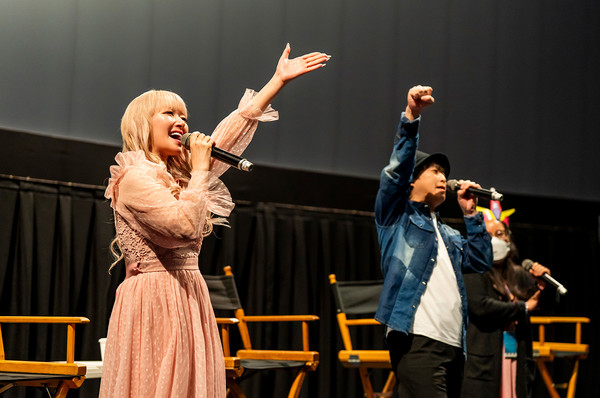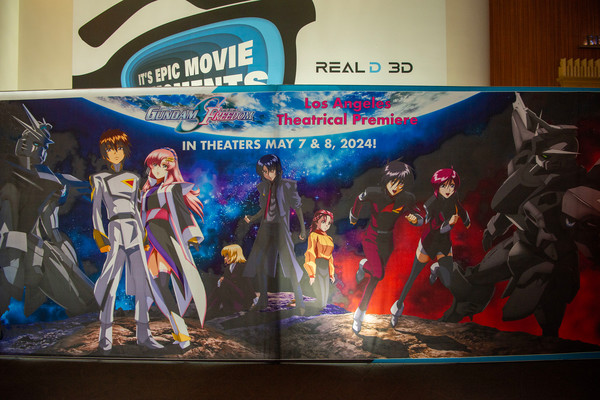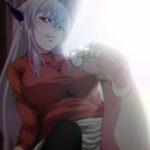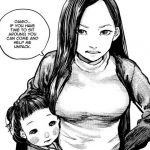The two leads of Mobile Suit Gundam Seed FREEDOM have had a busy week as they have been promoting the film’s West Coast U.S. premiere. They went to the Seattle celebrations right away, and then they went to the Los Angeles film premiere with Michael Sinterniklaas (the producer of the Gundam Seed dub) and Stephanie Sheh (the English voice of Lacus Clyne). Cosplayers and fans mixed in the foyer as people waited impatiently for the film to start, snapping selfies with the movie banner and admiring the Gundam Seed toys. While Sōichiro Hoshi went for streetwear that included sneakers with blue and red highlights reminiscent of Kira’s Freedom Gundam, Rie Tanaka dressed like Lacus Clyne in a lacy pink dress.
Upon entering a crowded two-story auditorium, the four guests gave a pre-show speech and shared their reflections on their time spent working on the series. Hoshi and Tanaka were both thrilled to see the L.A. audience and expressed how amazed—even astounded—they were by the crowd’s size and the length of time it took them to find seats. The overwhelming enthusiasm that American fans have shown for the Gundam Seed series has never ceased to astound them, even though they are able to witness the excitement of Japanese fans firsthand.

For us, filming this series was like living in a fever dream, which is why it feels so strange. The 98 episodes were completed in a few months, and the distribution was delayed, according to Sheh. “It was quite difficult to assess the level of production. I didn’t really understand the show, even though I’d been told it’s incredibly popular. She was right, Sinterniklaas said, pointing out Bandai’s contributions to the Gundam Seed series. “We are extremely appreciative of Bandai Namco Filmworks, who have collaborated with us since Sunrise and helped to keep everything running smoothly.”
Hoshi and Tanaka turned to look at Lacus and Kira again, remembering those first several days of recording the two characters. “I thought Kira and I had a lot in common during SEED. Hoshi recalled entering the ADR booth and feeling as though he was engaged in a daily struggle within. Tanaka expressed the pressure she had on herself to play Lacus as well. In terms of how their characters have developed over the previous 20 years, Hoshi believed that following Kira’s hardships in SEED, he became a “guest character who cameoed halfway” in DESTINY when the viewpoint shifted to Athrun Zala and Shinn Asuka. He expressed his hope that Gundam Seed FREEDOM fans won’t be surprised by his character now that the focus of the tale is back on Kira. He joked, “Don’t kirau [hate] Kira.”
Tanaka, on the other hand, reflected on Lacus and Kira’s connection over time. As Athrun’s fiancée, she was initially on the opposing side, so the first season laid the groundwork for their eventual blossoming romance. She urged readers to anticipate how their connection would continue to grow in FREEDOM after it blossomed and matured in DESTINY.
Hoshi and Tanaka discussed their lengthy history with the Gundam Seed franchise, how Lacus and Kira’s relationship has changed, and the difficulties they faced when making a comeback for Gundam Seed FREEDOM with Anime News Network prior to the debut.
The original series aired more than 20 years ago. Was it tough to play Kira and Lacus again after all this time?
Hoshi: I’ve been playing the part for twenty years now. However, there’s an annual opportunity to rekindle the relationship with Gundam Seed and Gundam Seed Destiny by exchanging a few words through different events and possibilities. Since Kira and I seem to have been together forever, I had no trouble getting back into character. The timeframe of the story begins around two years after DESTINY. I didn’t try to go back and play Kira the way I had played him the first time I had to replay him. However, it was almost like acting through those twenty years as Kira with my present self. Though I wouldn’t really describe it as a reimagining, I made an effort to channel the persona once more, which was novel for me.
Tanaka: For the movie, I had to completely redo the character. She underwent development from this cuddly and adorable figure throughout the franchise timeline. I didn’t think she would change, but as time went on, she developed into a strong individual who can communicate with people in her immediate vicinity. During the ADR recording sessions, the director also instructed me to slightly alter her character. My perception of Lacus changed after I read the screenplay and then started recording because the director gave me direction.
What thoughts or emotions did you experience when you learned that you would be appearing in the Gundam Seed series?
Hoshi: I remember liking gunpla and seeing [Gundam] when I was younger, probably in elementary school. As an adult, the Gundam series had expanded significantly. Although there weren’t many opportunities at initially, I felt like I was able to become closer to the Gundam franchise as a voice actor. Hearing that I had been cast for Gundam Seed made me feel as though my childhood fantasies and my ambition to be a part of [the franchise] had finally come true. That was, of course, one of my very, very happy moments.
Tanaka: I also recall my first exposure to Gundam, which at the time was Gundam Wing, as a high school student. I got into it, but back then there were no boundaries for boys and females to get into the series. Since I recall purchasing a lot of items personally, I believe Gundam Wing contributed to the growth of the fan base. I joined in the voiceover academy a few years later.
I didn’t initially audition for Lacus Clyne; instead, I was cast as Flay Allster. I was asked if I could sing, so they changed my role because the character required to sing. We recorded “Shizukana Yoru ni,” Lacus’s debut tune, first, and then her voice. While we were working on that, the director of Gundam Seed entered the studio, introduced herself, and showed me the illustrations of Lacus. I recall the singing process and how I incorporated her character into the acting and musical performance because it was my first role. However, I remember the pressure I had in my early 20s to assume such a large role. I gave it everything I had, and look at us today.
Following on from Gundam Seed and Gundam Seed Destiny, Gundam Seed FREEDOM illustrates the strong relationship and trust that exist between Kira and Lacus. How do you feel about Kira and Lacus’s relationship?
Hoshi: I believe our relationship as actors developed during the course of recording Gundam Seed and continued into DESTINY. I felt safe in each other’s company when DESTINY arrived—maybe even too safe or too at ease. We almost seem like this elderly married couple. Neither in the story nor in the performances did our characters seem to be experiencing any romantic tension. In spite of this, we were able to establish some rapport and confidence. We were led in that path by the filmmaker, particularly because DESTINY leads into FREEDOM and there are a lot of unexpected things that happen.
Tanaka: Because Athrun and Lacus were thought to be a suitable genetic and political match, Lacus was originally set to wed her. There wasn’t much love [between them] because the match was established without much romanticism. Lacus feels that fresh feeling when she first meets Kira. She has a difficult time being identified early on since you can’t tell what she’s thinking. In my opinion, she had sentiments for Kira, which are much more evident in DESTINY. Additionally, Kira doesn’t always feel that amorous feeling. Kira is mostly motivated by his need to keep his Natural buddies safe. including Kira, Lacus also wishes to put an end to the violence, so she considers ways to do so sooner, including singing, preaching peace, or using diplomacy.
Meanwhile, Kira is having his own struggles on how he should be fighting. Everyone is ultimately moving toward global peace. She feels a personal need to defend others around her. This is demonstrated by DESTINY leading to FREEDOM. The major unexpected development that Hoshi alluded to previously was Orphee’s obstructionism as a more recent adversary. He has a strong sense of control and the ability to manipulate others. Kira feels saddened when even Lacus gives in to pressure. In FREEDOM, we witness the complexity of interpersonal connections. It’s unexpected, and I believe the audience is going to go on an amazing adventure.
As you’ve already stated, one of your most difficult tasks is Lacus. How did you modify your acting to suit the changes in Lacus’s persona, from idol singer to peacefully spending her life as the head of COMPASS?
Tanaka: There is a small distinction in Lacus between SEED and DESTINY, but as president of COMPASS, she is under more pressure to safeguard various people in FREEDOM. In addition, although she and Kira share a residence, their communication and spending time together has decreased dramatically. After two years, Lacus has become even more of an adult, and her animation and design reflect this. At times, I was even unsure of how to depict her development and their relationship as I wondered how best to approach that from an acting standpoint. There are always new and varied adversaries and rivals in FREEDOM. Even though she is imprisoned and even gets captured, she has evolved into someone other than the Lacus you have been familiar with. She’s a prisoner of sorts, but she manages to travel and exert influence, and I had to change a lot of my acting for her.
Kira has gone through a lot in terms of trials and suffering from fighting. Which obstacles and problems did you encounter when voicing Kira?
Hoshi: I feel connected to Kira’s struggles with numerous things that he doesn’t grasp since SEED. Week after week, I battled and overcame unidentified obstacles with Kira. When DESTINY finally arrives, Kira has changed and developed into a determined adult. It seemed to me that he had arrived at a stable and secure place. However, Kira still harbors a part of her vulnerability—what one could call her human weakness—when it comes to FREEDOM. Kira is still not as mature as I had assumed, I realized. In that way, I gave new thought to both the Kira in the film and the Kira I had created for myself. That, in my opinion, was the most difficult aspect of recreating the character found in FREEDOM.
What do you think about admirers that live abroad? Did you anticipate Gundam Seed’s international success?
Tanaka: Gundam Seed’s fame [in the US] was first brought to my attention when I got the chance to attend an event in Chicago. I was surprised to see that fans dressed like Lacus, Kira, and Meer. Having the opportunity to visit Seattle, a few cosplayers and fans expressed to us their enthusiasm for Gundam Seed. They loved the show so much that they even decided to learn Japanese in order to watch it in its original tongue without subtitles. It was a very meaningful and touching moment for me. I was really happy that I agreed to portray Lacus.
Hoshi: To be honest, I had no idea Gundam Seed was that well-known. I was certain there was a certain level of global fame because I had been aware of the Gundam series and franchise since its inception. However, I receive none of that news in Japan. I was able to visit Seattle as a result of this trip, and I spoke with a few fans during the panel discussions and signing sessions. For the first time, I could actually see the excitement and expectation of people who have followed Gundam Seed since its debut in 2002 when I saw that immediate response from the fans. After much anticipation, fans have been waiting impatiently for more of the tale. It demonstrated how the fans in the United States and Japan are similar in their eagerness for the upcoming Gundam Seed installment.
Hoshi—possibly speaking for Kira—threw a curveball in their farewell speech, telling the crowd to look out for Lacus. He was jokingly insistent on shielding her from a certain “character,” but Tanaka had to stop and remind him not to mention Orphee’s name. Tanaka and Sheh both stood up to read Lacus’ well-known quote, “You don’t love someone only because you need them,” as a special gift for everyone in attendance. You adore them, so you need them.



